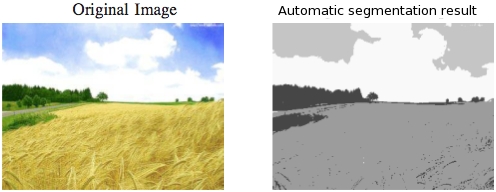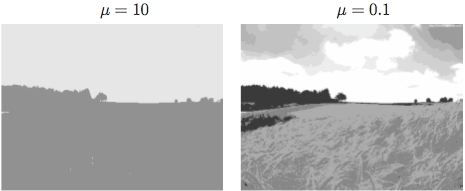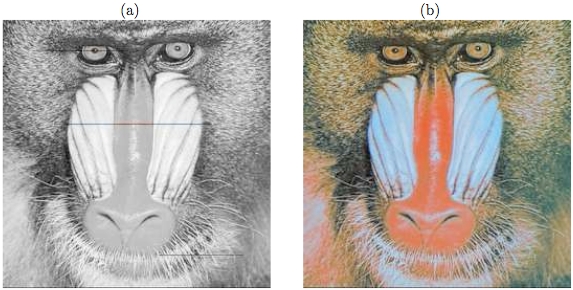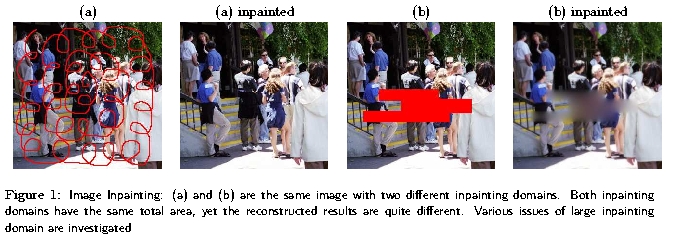Kang, Sung Ha
Assistant Professor, School of Mathematics, Georgia Institute of Technology
Research Interests
Mathematical approaches to image processing and computer vision.
Variational functional and PDE based methods for various problems arising in image restorations and segmentation: denoising, deblurring, inpainting, color image, video, shape analysis, texture, multiphase image segmentation and various extensions.
New modeling of functionals, mathematical analysis and numerical simulations.
Numerical methods and scientific computing, level-set methods, wavelets and applied differential equations.
Updated May 2010
1. Image Segmentation is one of the classical image processing task, where the objective is to partition the image into different regions. It simplifies the image and allows to easily identify certain objects in the image. Image segmentation is closely related to active contour which objective is to find the boundary of the objects in the image.
(1) Unsupervised multiphase segmentation: a phase balancing model.
Different from the case of two-phase identification, multiphase case has sensitivity issues: choosing an initial condition and pre-assigning the number of phases before the segmentation is performed.
These issues of automatic choice of the number of phase k and sensitivity are addressed by unsupervised model.


This model automatically chooses a reasonable number of phases (with mu=1) as it segments the image via the minimum of the following functional. This functional has interesting properties such as giving balance among different phases, good detail recoveries, flexibilities allowed by the choice of parameter and applications to image quantization and others. (In the right, two images show the effects of having a different choice of the parameter.)
(2) A variational model for infinite perimeter segmentation.
We proposed a new model of image segmentation which captures the oscillatory boundary while denoising the image. A typical segmentation model uses the total length penalization regularization, and this term is replaced by the area of the boundary neighborhood in the new model. The objective is to keep fine details and irregularities of the boundaries while denoising additive Gaussian noise. This is an initiating work on capturing the fine details of the boundary in image segmentation problem.

(a) Given noisy image. (b) and (c) are segmentation results this model, where
Minkowski content is used in place of the typical total length term. With a different choice of
parameters, one can segment the image similar to that of piecewise constant Mumford-Shah
model (b) or capture more details of the boundary as in (c).This model allows the boundary with infinite perimeter, as long as it can be included in the epsilon bound.
- Marco Barchiesi, Sung Ha Kang, Triet Le, Massimiliano Morini, Marcello Ponsiglione, "A variational model for infinite perimeter segmentations based on Lipschitz level set functions: denoising while keeping finely oscillatory boundaries", Accepted SIAM Multiscale Modeling and Simulation 2010
- Preprint available at: Hausdorff Research Institute preprint, Analysis, Sep-Dec 2008
(3) Multiphase image segmentation via Modica-Mortola phase transition.
Using a well-potential is frequently studied in material science problems of phase transition, which has recently been introduced to imaging applications. These connections between phase transition model and image segmentation are quite natural: the phases in material sciences are characterized by densities and tensions, while in imaging object segments are characterized by some key visual features such as intensities and orientations.

We proposed a model built upon Modica-Mortola phase transition that represents each segment by an integer. With a single function z, the computation becomes quite simple and multiple phases are naturally found by the minimum (wells) of the functional. These studies are closely related to calculus of variation and analysis, and these studies also provide practical and realistic applications of such theoretical models.
- Yoon Mo Jung, Sung Ha Kang and Jianhong Shen, ``Multiphase Image Segmentation via Modica-Mortola Phase
transition'', SIAM applied Mathematics , Volume 67, Issue 5, Pages 1213- 1232, 2007.
- Full color preprint available at UCLA CAM06-31, and IMA preprint 2124, June 2006
(4) Image quantization:
We explored the computational aspect of the celebrated Total Variation denoising model. This work is on a discrete version of total variation minimizing computation using stochastic/Markovian gradient descent method. Figure 5, we demonstrate the quantization performance of the free quantum TV model with five levels.
- Jianhong Shen and Sung Ha Kang, ``Quantum TV and Applications in Image Processing'', Volume 1, Number 3, Pages 557-575, 2007
- preprint UCLA CAM07-09
2. Image deblurring is one of the classical but difficult problems due to its ill-posedness. The objective is to recover out-of-focus images. A blurry image is typically assumed to be generated via Gaussian kernel convoluted with the original image.
 With my Ph. D student, we explored a blind image deconvolution problem, where there are no assumptions on the type of a blur kernel. This model utilizes an initial guess, given by the shock filter to get good edge information while minimizing a modified variational functional of Chan and Wong. The error bound estimate is included in this study. The computation time is significantly reduced while the numerical results show much improvement compared to previous blind deconvolution variational models. Since this method can be applied to any types of blur, it is quite stable and able to capture non-symmetric blur kernels such as a motion blur.
With my Ph. D student, we explored a blind image deconvolution problem, where there are no assumptions on the type of a blur kernel. This model utilizes an initial guess, given by the shock filter to get good edge information while minimizing a modified variational functional of Chan and Wong. The error bound estimate is included in this study. The computation time is significantly reduced while the numerical results show much improvement compared to previous blind deconvolution variational models. Since this method can be applied to any types of blur, it is quite stable and able to capture non-symmetric blur kernels such as a motion blur.
- James H. Money and Sung Ha Kang, ``Total variation semi-blind
deconvolution using shock filters'', in Image and vision computing , Volume 26, Issue 2, Pages 302-314, 2008.
- Preprint IMA preprint 2106, March 2006
3. Colorization refers to recovering color of gray scale images when only small regions with color are given. The term ``colorization" was introduced by Wilson Markle who first processed the gray scale moon image from the Apollo mission. More recently a specific application was considered by Fornasier, where colorization was used to reconstruct the frescoes (paintings) by A. Mantegna in an Italian church which was destroyed during World War II. There are photos of the full frescoes available in black and white, while only few real pieces of frescoes with original colors are remaining. This is one of the fundamental image reconstruction problem.
(1) Variational Models for Image Colorization
We proposed a couple of variational models using chromaticity color component to colorize black and white images. These proposed models are true to the objective of smooth color recovery and the convergence analysis backs up the successful numerical results. The image decomposition is applied in addition for texture colorization that was previously thought to be one of the difficult problems.

- Sung Ha Kang and Riccardo March, ``Variational Models for Image Colorization via Chromaticity and Brightness Decomposition'', IEEE transaction in Image Processing, Volume 16, Number 9, Pages 2251-2261, 2007
- Full color images available at : IMA preprint 2138, October 2006
(2) Reproducing Kernel Hilbert space (RKHS) for image and video colorization
The setting of RKHS and its extensions are widely considered in machine learning. We proposed the first work applying RKHS framework to image and video colorization, and the vectorial settings of RKHS are analyzed.
 In this image, (a) is the given image, and (b) is the colorization result . Less than 0.5% of color is given: around the left eye, middle of the nose, and right bottom corner. The small region of given color makes the numerical computation efficient, and the colorization result is realistic. The explicit solution is superior compared to any iterative methods, and the flexibility of choosing different kernels allows easy colorization on texture image as well as cartoon images. Colorization results show big improvements in speed and quality.
In this image, (a) is the given image, and (b) is the colorization result . Less than 0.5% of color is given: around the left eye, middle of the nose, and right bottom corner. The small region of given color makes the numerical computation efficient, and the colorization result is realistic. The explicit solution is superior compared to any iterative methods, and the flexibility of choosing different kernels allows easy colorization on texture image as well as cartoon images. Colorization results show big improvements in speed and quality.
- Minh Ha-Quang, Sung-Ha Kang, and Triet M. Le, ``Image and Video Colorization Using Vector-Valued Reproducing Kernel Hilbert Spaces", Journal of Mathematical Imaging and Vision, Volume 37 , Issue 1, Pages: 49 - 65, 2010
- Preprint available at: UCLA CAM09-46
4. Color image analysis
(1) Color image decomposition: Y. Meyer introduced an image decomposition, which is to split an image into two components: a geometrical component and a texture (oscillatory) component. This notion of G-norm, which captures the oscillation of the images, has contributed a great deal on image texture analysis.
 We proposed one of the first models on color image texture decomposition, where the G-norm for color image was defined as the polar semi norm associated to the 3D total variation semi norm. These analyses, linking the proposed model with total variation and showing the existence and uniqueness of the solution, provided insights into the fundamentals of color textured images and numerical experiment validated the model.
We proposed one of the first models on color image texture decomposition, where the G-norm for color image was defined as the polar semi norm associated to the 3D total variation semi norm. These analyses, linking the proposed model with total variation and showing the existence and uniqueness of the solution, provided insights into the fundamentals of color textured images and numerical experiment validated the model.
- Jean-Francois Aujol and Sung Ha Kang, ''Color Image Decomposition and Restoration'', Journal of Visual Communication and Image
Representation , Volume 17, Number 4, pages 916-928 2006.
- Full color images available at: UCLA CAM04-73.
(2) Color Spaces and denoising: Chan, Kang and Shen, we explored various color spaces for the best color image denoising. We studied the Chromaticity-Brightness (CB) model and Hue-Saturation-Value (HSV) model, and found out it is best to treat color as one component, but independently to the brightness.
- Tony. F. Chan, Sung Ha Kang and Jianhong Shen, ``Total Variation Denoising
and Enhancement of Color Images Based on the CB and HSV Color
Models'', Journal of Visual Communication and Image Representation, 12 : 422-435, 2001.
- Full color images available at: UCLA CAM00-25.
5. Image Inpainting refers to a specific image restoration task, where missing or damaged portions of an image are reconstructed. Digital image inpainting became very popular thanks to the work by Bertalmio, Sapiro, Caselles, and Ballester [ Proc. Siggraph 2000] where the authors use third order partial differential equations (PDE) to diffuse the known image information into the missing regions along the level lines. Masnou and Morel [Proc. IEEE Int'l Conf on Image Proces. 1998] drew our attention to variational models.

(1) In Chan, Kang and Shen, we introduced the Euler's Elastica Curvature to the variational functional for higher order image inpainting. This is one of the natural ways to improve the TV inpainting method.
- Tony Chan, Sung Ha Kang and Jianhong Shen, ``Euler's Elastica and Curvature Based Inpaintings'',
SIAM journal on Applied Mathematics, 63, number 2, page 564-592, 2002.
- preprint UCLA CAM01-12
(2). In Kang, Chan and Soatto, we introduced Inpainting from multiple view which deals with even larger missing regions, where it is not solvable with typical local inpainting methods.
- Full details and images are at UCLA CAM02-31, ``Landmark based inpainting from Multiple view'', March 2002
- Sung Ha Kang, Tony Chan and Stefano Soatto, ``Inpainting from Multiple view'', Proceedings of first international symposium on 3D Data Processing Visualization Transmission, Pages 622-625, 2002.
- preprint of Inpainting from Multiple view UCLA CAM02-11
(3) Chan and I investigated Error Analysis for Image Inpainting. This is the first work on error analysis for image inpainting. For general inpainting experiments, local inpainting methods work well for narrow inpainting domains, and the error bounds give analysis on this phenomenon.
- Tony F. Chan and Sung Ha Kang, `` Error Analysis for Image
Inpainting'', Journal of Mathematical Imaging and Vision , Volume 26, pages 85-103, 2006.
- Preprint with full color images available at: UCLA CAM 04-72.
6. Image and Video Dejittering occurs when the horizontal lines of video image frames are randomly displaced due to the corruption of synchronization signals or electromagnetic interference during video transmission.
 (1) Shen and I proposed a PDE based dejittering approach Video Dejittering by Bake and Shake. This method gives very robust numerical results and one example is shown in Figure 2.
(1) Shen and I proposed a PDE based dejittering approach Video Dejittering by Bake and Shake. This method gives very robust numerical results and one example is shown in Figure 2.
- Sung Ha Kang and Jianhong Shen, "Video Dejittering by Bake and Shake",
Image and vision computing, Volume 24, Issue 2, Pages 143-152, 2006.
- Full color images available at: UCLA CAM 04-60.
(2) Extension of this work is explored in On the Slicing Moments of BV Functions and Applications to Image Dejittering. By regularizing the moment function, this method allows to recover even a very thin lines which was impossible from previous dejittering methods.









